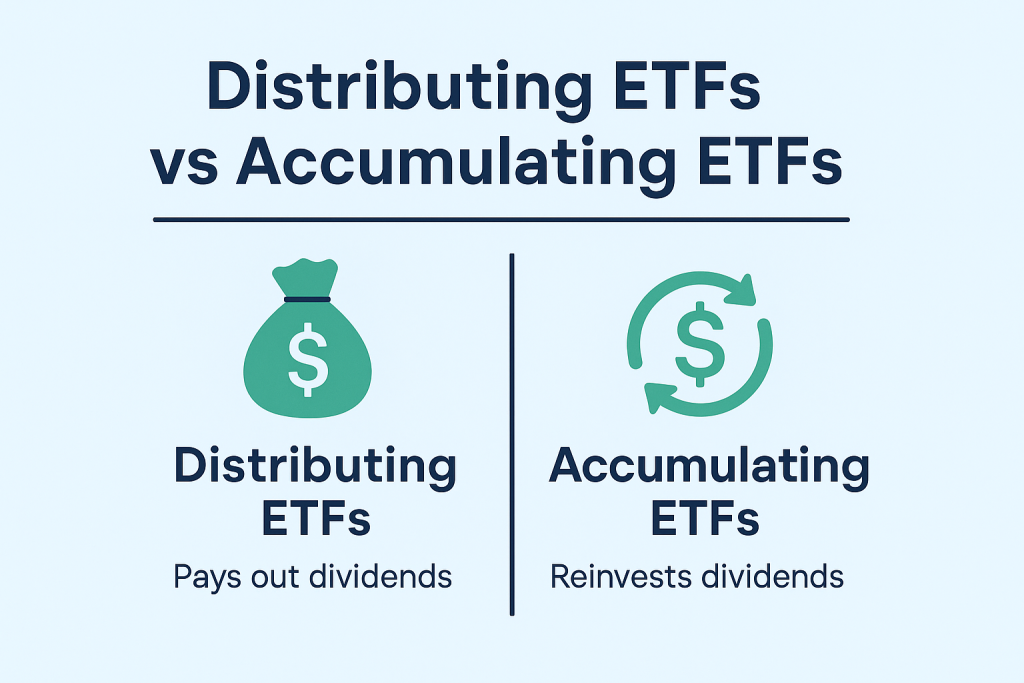If you’re new to ETF investing, you may notice something confusing:
👉 Some ETFs pay out dividends into your account, while others don’t.
The difference? It’s whether the ETF is distributing or accumulating.
Here’s the simple breakdown.
📌 What Are ETF Distributions?
ETFs hold baskets of stocks. When those companies pay dividends, the ETF receives them.
- If the ETF pays the income out to you, it’s called distributing.
- If the ETF reinvests it automatically inside the fund, it’s called accumulating.
✅ 1. Distributing ETFs (Cash-Paying)
Definition: ETFs that pay out dividends or interest income to investors, usually every quarter or semi-annually.
Examples (U.S. market):
- Vanguard High Dividend Yield ETF (VYM)
- Schwab U.S. Dividend Equity ETF (SCHD)
- iShares Select Dividend ETF (DVY)
Pros:
- 💵 Cash flow: Regular income like a paycheck or side money.
- 👵 Great for retirees: Helps cover living expenses.
- 🔁 Flexibility: You can reinvest payouts yourself.
Cons:
- 💸 Taxable immediately: Dividends are taxed in the year received.
- 📉 Lower compounding: Money leaves the fund instead of growing inside.
🔁 2. Accumulating ETFs (Reinvesting)
Definition: ETFs that automatically reinvest dividends back into the fund. Instead of cash payouts, the ETF’s NAV grows over time.
Examples (common in Europe):
- iShares Core MSCI World UCITS ETF (Accumulating)
- Vanguard FTSE All-World UCITS ETF (Accumulating)
Pros:
- 📈 Stronger compounding: Dividends reinvest automatically.
- ⏳ Tax deferral: Depending on your country, you may pay taxes only when selling.
- 🚀 Great for long-term growth.
Cons:
- ❌ No cash flow: Not ideal if you rely on income.
- 🕒 Less flexibility: You can’t decide when to take dividends.
📊 Side-by-Side Comparison
| Feature | Distributing ETFs (Cash) | Accumulating ETFs (Reinvesting) |
|---|---|---|
| Income treatment | Paid out in cash | Reinvested inside the fund |
| Cash flow | Yes, regular payouts | None |
| Compounding | Lower (manual reinvest) | Higher (automatic) |
| Tax | Taxed when paid | Tax deferred until sale |
| Best for | Income-focused investors | Long-term growth investors |

🎯 Which One Should You Choose?
“Do I want cash in hand now or automatic growth for the future?”
That’s the key question.
Choose Distributing ETFs if:
- You want regular income.
- You rely on dividends to support expenses.
- You like seeing payouts in your account.
Choose Accumulating ETFs if:
- You prefer compounding over cash flow.
- You’re investing long-term.
- You want to defer taxes until you sell.
👉 Many investors hold both types: distributing ETFs for income and accumulating ETFs for growth.
💬 Final Thoughts
There’s no single “best” ETF type. It all depends on your goals, lifestyle, and tax situation.
By understanding the difference between distributing vs accumulating ETFs, you’ll make smarter choices for your portfolio.
📝 Disclaimer
This article is intended for educational purposes only. It does not constitute financial, investment, or legal advice. All investment decisions involve risks, and readers should conduct their own research or consult with a licensed financial advisor.
